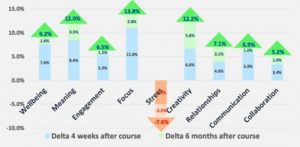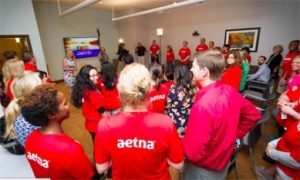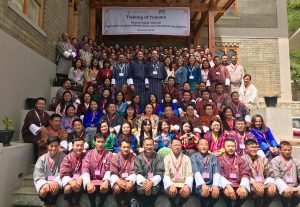Mindfulness Champions in Organizations
The way we function in contemporary organizations is not working because employees are more stressed, anxious, burned out and disengaged than ever before. The United Nations International Labour Organization reports that work-related stress is a major epidemic worldwide with 40 to 60 percent of workers in industrialized economies experiencing moderate to high stress at work (1). Employees continue to struggle to find ways to work in contemporary always-on, global, high-stress, high-velocity work environments (2). Globally, we know that 85 percent of employees worldwide are not engaged or are actively disengaged in their job (3) (measured as the degree to which employees feel rationally and emotionally committed to their work and/or organization). One positive development that offsets this trend is the growing set of internal employees who are mindfulness champions within their organizations.
While the challenges to create a truly thriving workplace can be high, some of the mindfulness champions we highlight here have had significant, measurable impact through the solutions they offer their organizations. We know that thriving workplaces have tangible benefits. For example, organizations that prioritize sustainable employee engagement outperform organizations with low engagement by a factor of 3x, according to global HR consultancy Towers Watson; companies on the FTSE 100 that prioritize employee well-being and engagement outperform competitors by 10 percent, according to the Workwell study conducted by the FTSE; and such companies as SAP, the German enterprise software company, save hundreds of millions in operating profit by investing in employee well-being and engagement. It clearly makes good business sense to address and invest against the deterrents of a healthy workplace.
Peter Bostelmann, SAP
One person who is making the health and business impact of mindfulness practices real in his organization is Peter Bostelmann, head of the Global Mindfulness Practice at SAP. Bostelmann took our core Search Inside Yourself (SIY) mindfulness-based emotional intelligence training nearly a decade ago and realized he could introduce SIY’s science-based approach to mindfulness and emotional intelligence at SAP, first through a set of pilot programs. Based on the overwhelming success of these pilot sessions, he was able to garner increasing levels of executive support, and eventually SAP began offering more robust open enrollment programs to all employees.
A key to Bostelmann’s success was thinking big but also introducing mindfulness to SAP in stages. Initially, Bostelmann began at the grassroots level, sharing his own life-changing experiences with mindfulness and its benefits with colleagues. Bostelmann then offered introductory keynotes in conjunction with SIYLI and linked mindfulness outcomes to company priorities, such as employee engagement and operational excellence. Further partnering with SIYLI, Bostelmann then offered SIY pilots to executives, as well as open enrollment sessions. After collecting positive feedback, he was able to get executive-level sponsorship and has been expanding SAP’s mindfulness offerings ever since, including conducting several SIY train-the-trainer cohorts so that SAP employees could teach mindfulness-based emotional intelligence in credible and compelling ways to their colleagues.

Peter Bostelmann teaching mindfulness skills to a large group of SAP employees. Every year, SAP puts over 2,500 employees through SIY’s signature mindfulness-based emotional intelligence programs.
Through Bostelmann and his team’s efforts, including other SIY alumni and mindfulness enthusiasts at SAP, thousands of employees are taking SIY mindfulness-based emotional intelligence curriculum every year—and the outcomes are compelling. SIY participants at SAP report 6.5 percent greater employee engagement, 9.2 percent better well-being, 13.8 percent improved focus, -7.6 percent less stress, 6.9 percent better communication and 5.2 percent better collaboration. SAP has also reports that every 1 percent increase in employee well-being/health index equates to 85 to 95 million euros per year in increased operating profit, and every 1 percent increase in employee engagement equates to a 50- to 60-million euro increase in operating profit. These metrics are critical considering that SIY increased participants’ overall well-being by 9.2 percent and engagement by 6.5 percent. In fact, SAP has indicated there is a 200 percent return on investment from SIY mindfulness programs (based on 5,500 SIY participants compared with a relevant control group through 2018). These outcomes suggest that mindfulness isn’t just a nice-to-have offering, but rather mindfulness and the effects it can have on employees make it a an undeniably good investment that contributes to strong business results.

SIY outcome metrics at SAP. Results from 187 participants at SAP. Comparison of participant experience pre-SIY program, then at four weeks post-program and six months post-program.
SIY’s success comes about in large part because we draw on neuroscience as a foundation for the development of the useful mental habits and skills, such as mindfulness and resilience, that can be activated during everyday work and life. We also offer a blended learning solution that incorporates live sessions with digital learning and webinars, ensuring learning sustainment. This overall approach is especially important for employees who are under a lot of pressure and/or those who work in particularly challenging environments, where acquiring and sustaining useful mental habits and navigational skills is particularly important.
These outcomes suggest that mindfulness isn’t just a nice-to-have offering, but rather mindfulness and the effects it can have on the employees make it a an undeniably good investment investment that contributes to strong business results.
Jenee Johnson and Lisa Reyes, San Francisco Department of Public Health (SFDPH)
Over the past two years, for example, SIYLI has deepened its engagement with the San Francisco Department of Public Health (SFDPH), which runs all of the homeless shelters, jails and city hospitals in San Francisco. In particular, SFDPH employees Jenee Johnson and Lisa Reyes have emerged as major advocates for mindfulness in their organization, and as SIY-certified teachers now offer mindfulness-based emotional intelligence programs to their colleagues. Johnson and Reyes emphasize the ways SIYLI’s mindfulness-based emotional intelligence curriculum helps SFDPH employees develop resilience for working on the frontlines in clinics, jails and social service agencies. Additionally, because some core attributes of the trauma-informed systems approach include safety, compassion and cultural humility, Johnson and Reyes view the mindfulness and emotional intelligence skills that SIY builds as critical to operationalizing and making practical the core pillars of trauma-informed systems approaches to field work. Johnson and Reyes are in the process of collecting data on the impact of the SIY program, but across agencies at SFDPH there is strong and growing enthusiasm to offer SIY across their sites more broadly.

San Francisco Department of Public Health uses SIY to support its Trauma-Informed System model for working with diverse clients and communities.
Cheryl Jones and Andy Lee, Aetna
In terms of measurable results, we also want to highlight mindfulness champions Cheryl Jones and Andy Lee at Aetna, a leading insurance and health provider in the United States. Jones, who is the director of mindfulness at Aetna, and Lee, who is the chief mindfulness officer at Aetna, developed a mindfulness strategy for the company that included rolling out open enrollment mindfulness and yoga programs to employees. The outcomes? Over 12,000 employees attended these programs, and results indicate 62 minutes of increased productivity per week per employee, resulting in $3,000 savings per employee for the company in addition to overall improvements in employee well-being. Aetna’s experience suggests that employees participating in mindfulness programs not only perform better and support overall company performance, but also feel better and are healthier.

Aetna Director of Mindfulness Cheryl Jones speaking at the opening the organization’s first company-based mindfulness center.
Ministry of Education, Bhutan
Finally, we would like to highlight a different group of mindfulness champions that SIYLI is currently training: the school teachers in the nation of Bhutan. The project began when the Ministry of Education in Bhutan contacted SIYLI to help train the nation’s entire population of school teachers because it valued SIY as a contemporary, science-based, non-religious, practical and accessible approach to mindfulness and emotional intelligence.
Working with the Ministry of Education, SIYLI helped identify and train 125 mindfulness champions who are school teachers. Once trained and certified by SIYLI, these teachers will then become the champions who will train all 10,000 other school teacher colleagues across the country. The ultimate goal is to teach emotional intelligence skills to Bhutan’s children to equip them with social competencies that will help them adapt and be more resilient in this ever-changing world.

SIY-trained school teachers in Bhutan during SIYLI’s recent train-the-trainer session.
We at SIYLI always seek to encourage mindfulness champions across sectors and industries because we believe that creating more mindful and compassionate work cultures promotes well-being, allowing both people, organizations and communities to be their best. Organizations and leaders certainly can, and do, function without these characteristics, but there are hidden costs. The core question becomes: What kind of leader do you wish to be, and what kind of team and culture do you want to create? Being a mindfulness champion is an important step on the path of integrating mindfulness practices into organizations, as our case examples illustrate.
If you’re interested in being a mindfulness champion in your organization or community, we encourage you to get started in whatever way best suits your circumstances. At SIYLI, we are always happy to talk and brainstorm ideas for how to bring mindfulness into your organization or community. We can share our lessons learned and best practices. If you think you and/or your organization could benefit from more mindfulness, check out our Organizational Teacher Certification as a way to make measurable impact at scale.
Finally, we want to share five tips for how you can be a champion of mindfulness in your own organization or community:
-
Practice What You Teach:
We like to say that “you can’t offer what you don’t have.” Because mindfulness centers offer direct experience (versus conceptual), we encourage you to deepen your own practice of mindfulness (whatever form that takes) in order to effectively share it and advocate for it with others.
-
Launch and Iterate:
When SIY was developed at Google, there was a philosophy that any good new offering or product would first need to be offered to the users and then refined based on lessons learned. The same is true for championing mindfulness offerings. They might not be perfect at first. You might need to start small. The important thing is to get started! It might be as simple as reserving a space and inviting colleagues to join you for a few minutes of mindful breathing and/or reflection. A helpful rule of thumb: Ask for forgiveness rather than permission.
-
Align Mindfulness Efforts with Organizational Priorities and Culture:
As a mindfulness champion in an organization or community, it’s important to remember that you don’t operate in a vacuum. Theress a broad ecosystem of stakeholders who are focused on goals that are specific to making that organization or community thrive based on its purpose, values, key performance indicators, etc. If you can link the value proposition of mindfulness to these priorities, chances of adoption and integration is much more likely. When SIY was started at Google, for example, one priority was to “create the happiest, healthiest and most productive workforce on the planet.” It turns out that SIY helped further those aspirations by developing skills for sustainable high performance, leadership and well-being, so it was extremely successful there. Find out what matters in your organization or community and consider the ways that mindfulness will support those efforts.
-
Assess Impact:
Showing some form of outcome data related to mindfulness efforts is always useful, especially for more skeptical stakeholders. These could be as simple as pre and post assessments of participant experiences with mindfulness or more detailed calculations of return on investment for mindfulness efforts. The important thing for mindfulness champions to consider is how to measure what matters to your stakeholders.
-
Find Allies and Sponsors:
In order to gain traction for mindfulness, especially in organizations, it’s essential to get buy-in from leaders and influencers. Usually a mindfulness champion can do this by sharing positive feedback and/or assessments of impact they have collected through efforts to pilot mindfulness offerings to their colleagues. Measuring impact and aligning that impact to priorities, as well as presenting initial suggestions for potential next steps, can be useful. Finally, as a champion for mindfulness it’s important to not go it alone. Rather, involve potential sponsors and/or allies in the process for any actions so that there’s a collective sense of ownership.
—Rich Fernandez, CEO of SIYLI
References
1. U.N. International Labour Organization, Workplace stress: A collective challenge, April 2016.
2. U.N. International Labour Organization, Global Commission on the Future of Work, Work for a Brighter Future, 2019.
3. Gallup, State of the Global Workplace, 2017